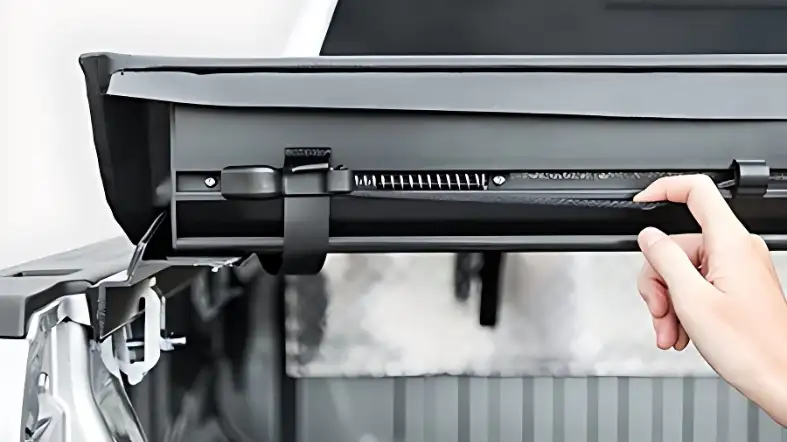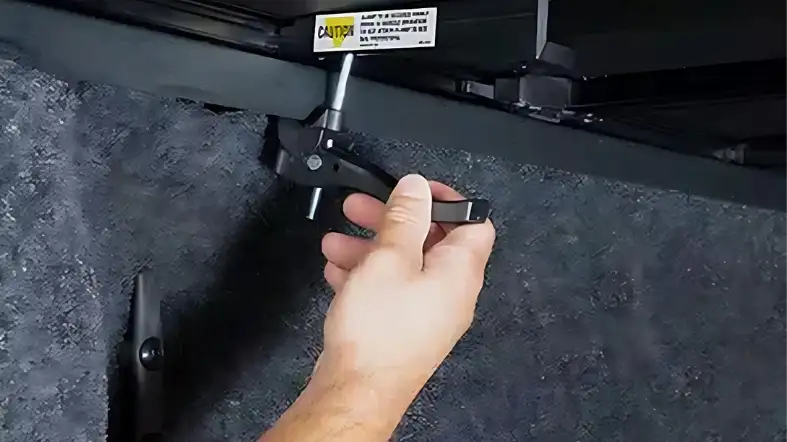Struggling with a faulty tonneau cover latch? Frustrated with a cover that won’t stay securely closed?
Don’t worry, we’ve got you covered! In this guide, we’ll walk you through the simple yet effective steps to fix your tonneau cover latch.
Whether it’s a broken latch, misalignment, or other issues, our expert tips and techniques will help you restore the functionality of your tonneau cover latch in no time.
Say goodbye to worries and hello to a fully functional tonneau cover. Let’s begin!

How to fix the tonneau cover latch?
Proper maintenance and prompt repairs are key to ensuring the optimal performance of your tonneau cover latch.
Stay proactive and address any latch issues promptly to enjoy hassle-free operation for years to come.
Tools and Material
1. Screwdriver: A screwdriver with the appropriate head (Phillips or flathead) to remove any screws or bolts holding the latch in place.
2. Lubricant: Choose a silicone-based lubricant specifically designed for automotive applications. This will help to reduce friction and allow the latch to operate smoothly.
3. Replacement Components: If your latch is damaged beyond repair, you may need to replace certain components. Contact the manufacturer or a reputable dealer to obtain the correct replacement parts.
4. Cleaning Supplies: It’s a good idea to have some cleaning supplies on hand to remove any dirt, debris, or rust that may be affecting the latch’s performance. Use a soft cloth, mild detergent, and water for cleaning purposes.
Step 1: Assessing the Latch Issue
When faced with a problematic tonneau cover latch, the first step is to accurately identify the issue.
Inspect the latch mechanism thoroughly, checking for any signs of damage, misalignment, or wear and tear.
Look out for loose screws, bent components, or obstructions that may be hindering proper latch operation.
Step 2: Gathering the Necessary Tools and Materials
Before diving into the repair process, make sure you have all the tools and materials at hand.
Commonly required items include a screwdriver set, pliers, lubricant, replacement latch components (if needed), and a clean cloth for cleaning purposes.
Having everything ready will streamline the repair process and prevent interruptions.
Step 3: Preparing the Tonneau Cover and Latch for Repair

To ensure a smooth repair process, it’s important to prepare the tonneau cover and latch.
Start by fully retracting or removing the cover according to the manufacturer’s instructions.
This will provide easy access to the latch mechanism. Additionally, clean the latch and surrounding areas to remove any dirt, debris, or rust that may interfere with the repair.
Step 4: Disassembling the Latch Mechanism
To fix the tonneau cover latch, you’ll likely need to disassemble the latch mechanism. Carefully remove any screws, bolts, or retaining clips that hold the latch in place.
Keep track of the order in which the components are removed to ensure proper reassembly later.
Step 5: Repairing or Replacing Faulty Components
Now it’s time to address the specific issue with the latch mechanism. Depending on the problem identified, you may need to repair or replace certain components.
This could involve tightening loose screws, straightening bent parts, or replacing broken or worn-out pieces.
Follow the manufacturer’s instructions or consult an expert if you’re unsure about any repair steps.
Step 6: Lubricating and Reassembling the Latch Mechanism
Once the necessary repairs or replacements have been made, apply a suitable lubricant to the moving parts of the latch mechanism.
This will enhance the smooth operation and prevent future issues. Carefully reassemble the latch components, ensuring they are aligned correctly and securely fastened.
Step 7: Testing the Latch Functionality
With the latch mechanism reassembled, it’s time to test its functionality. Close and secure the tonneau cover, ensuring that the latch engages properly.
Open and close the cover multiple times to verify smooth operation and secure closure.
If the latch still poses issues, revisit the previous steps to identify any missed repairs or adjustments.
Step 8: Taking Preventive Measures for Future Maintenance
To avoid future latch problems, it’s important to implement preventive measures.
Regularly inspect and clean the latch mechanism, remove any debris, and apply lubricant as needed.
Follow the manufacturer’s recommended maintenance guidelines to ensure the longevity of your tonneau cover latch.
Step 9: Exploring Professional Assistance Options
If the latch issue persists or you’re uncomfortable with DIY repairs, consider seeking professional assistance.
Local auto repair shops or dealerships specializing in tonneau covers can provide expert advice, repair services, or replacement options tailored to your specific needs.
How to identify the common Tonneau cover latch issues?
When it comes to your truck’s tonneau cover, a secure latch is essential for proper functionality and protection of your cargo.
However, latch issues can arise, compromising the cover’s effectiveness.
Here, you will learn how to identify common tonneau cover latch issues and troubleshoot them effectively.
Step 1: Visual Inspection
The first step in identifying latch issues is to conduct a visual inspection. Start by examining the latch mechanism itself.
Look for any signs of damage, such as bent or broken components.
Additionally, check if there are any loose or missing screws or bolts that secure the latch. These visual cues can give you an initial idea of the latch’s condition.
Step 2: Test the Latch Functionality
To further assess the latch, it’s crucial to test its functionality. Open and close the tonneau cover several times while paying close attention to how the latch engages and disengages.
If you notice any sticking, resistance, or difficulty in locking or unlocking the latch, it indicates a potential issue.
Step 3: Check the Alignment
A misaligned tonneau cover can lead to latch problems. Examine the alignment of the cover by closing it and observing if it sits evenly on all sides.
If you notice any gaps or unevenness, it may be a sign of misalignment.
Additionally, inspect the alignment of the latch itself to ensure it aligns properly with the corresponding receiver on the truck bed.
Step 4: Lubrication
Lack of lubrication can cause latch issues, particularly if the mechanism feels stiff or struggles to engage.
Apply a silicone-based lubricant to the latch components, including the moving parts and contact points.
Be sure to follow the manufacturer’s recommendations regarding the type and amount of lubricant to use.
Lubrication helps reduce friction and allows the latch to operate smoothly.
Step 5: Tension Adjustment
Tension adjustment is crucial for proper latch functionality. Some tonneau covers have adjustable tension settings, allowing you to tighten or loosen the latch as needed.
Refer to the cover’s user manual for instructions on how to adjust the tension.
If your cover doesn’t have adjustable tension, consider contacting the manufacturer or a professional to assess and adjust it appropriately.
Step 6: Replace Damaged Components
If you’ve identified specific damage to the latch mechanism during the visual inspection, it may be necessary to replace the damaged components.
Contact the manufacturer or a reputable dealer to obtain the correct replacement parts.
Follow the manufacturer’s instructions or seek professional assistance if needed to ensure the new components are installed correctly.
Step 7: Seek Professional Assistance
If you’ve followed the previous steps and the latch issues persist, it may be time to seek professional assistance.
Contact a qualified technician who specializes in tonneau cover repairs.
They have the expertise and tools to diagnose and address more complex latch issues that require professional attention.
Preventive Maintenance and Care for Tonneau Cover Latches

Inspecting and maintaining your tonneau cover latches is crucial to ensure their optimal functionality and longevity.
These latches secure your tonneau cover, protecting your truck bed and its contents from the elements and potential theft.
By following a few simple preventive maintenance steps, you can keep your tonneau cover latches in excellent condition. Here’s what you need to do:
Regular Cleaning
To start, keep your tonneau cover latches clean by removing any dirt, debris, or grime that may accumulate over time.
Begin by spraying a mild detergent or soapy water solution onto a soft cloth or sponge.
Gently wipe down the latches, paying close attention to the areas where they make contact with the tonneau cover and the truck bed.
Rinse the latches thoroughly with clean water and dry them using a lint-free cloth.
Regular cleaning will prevent the buildup of contaminants that could interfere with the latch mechanism.
Lubrication
Proper lubrication is vital to maintain smooth and effortless latch operation. Begin by selecting a high-quality silicone-based lubricant specifically designed for automotive use.
Apply a small amount of lubricant to a clean cloth or directly onto the latch mechanism.
Carefully coat all moving parts of the latch, including hinges, pivot points, and springs.
Make sure to distribute the lubricant evenly and avoid excess buildup. Lubricating the latches regularly, ideally every three to six months, will reduce friction, prevent rust, and keep the mechanism functioning optimally.
Inspection
Regularly inspect your tonneau cover latches to identify any signs of wear, damage, or misalignment.
Check for loose or missing screws, bent components, or worn-out latch surfaces. If you notice any issues during the inspection, take prompt action to address them.
Tighten loose screws, replace damaged components, or realign misaligned latches according to the manufacturer’s instructions.
Early detection and timely repairs will prevent further damage and ensure the latches continue to operate effectively.
Weatherstripping Maintenance
In addition to caring for the latches themselves, maintaining the weatherstripping around your tonneau cover is crucial for overall protection and latch performance.
Inspect the weatherstripping regularly for signs of wear, cracking, or detachment.
If you notice any damage, replace the weatherstripping promptly to maintain a proper seal.
A well-sealed tonneau cover reduces the risk of water leaks and keeps your latches secure and functional.
Mindful Usage
While caring for your tonneau cover latches is important, using them correctly is equally crucial.
Avoid slamming the tonneau cover shut, as this can strain the latches and potentially cause damage.
Instead, close it gently and ensure the latches engage properly.
When opening the cover, use the designated release mechanism or handles, if provided, to prevent unnecessary stress on the latches.
By using your tonneau cover with care, you can extend the lifespan of the latches and avoid preventable issues.
Can Cleaning the Vinyl Tonneau Cover Help Fix the Latch Issue?
Cleaning a vinyl tonneau cover can potentially help fix the latch issue. Over time, dirt, dust, and debris can accumulate on the cover, affecting its flexibility and making it challenging for the latch to properly engage. By regularly cleaning the vinyl tonneau cover, you can ensure that it remains in optimal condition, allowing the latch to function correctly and securely.
FAQs
What should I do if my tonneau cover latch is loose?
Tighten the screws or bolts that secure the latch to the tonneau cover or truck bed.
If the latch continues to be loose, inspect for any damaged or stripped threads and consider replacing the fasteners if necessary.
Tonneau Cover Latch Is Stuck. How Can I Fix It?
Apply a silicone-based lubricant to the latch mechanism and work it back and forth to loosen any stuck parts.
If the latch remains stuck, carefully inspect for any bent or misaligned components that may need adjustment or replacement.
Can I Repair A Broken Tonneau Cover Latch Myself?
It depends on the extent of the damage. Minor repairs like replacing springs or hinges can be done by following manufacturer instructions.
However, for significant damages or if you’re unsure, it’s best to consult a professional or consider a replacement latch.
How Do I Know If I Need To Replace My Tonneau Cover Latch?
If the latch is severely damaged, broken, or worn beyond repair, it’s time for a replacement.
Additionally, if the latch repeatedly fails to secure the tonneau cover properly, it poses a risk to your cargo’s safety and necessitates a replacement.
Are Tonneau Cover Latches Interchangeable Between Different Brands And Models?
Not necessarily. Tonneau cover latches are designed to fit specific brands and models, so it’s crucial to find a latch that matches your tonneau cover’s specifications.
Refer to the manufacturer’s recommendations or consult a professional to ensure compatibility.
Where Can I Find Replacement Tonneau Cover Latches?
Replacement latches can be found at authorized dealerships, specialized truck accessory shops, or online retailers.
Research reputable sellers and ensure the replacement latch matches your tonneau cover’s brand and model for proper fit and functionality
Final Words
Get back on the road with a fully functional tonneau cover latch. By following simple maintenance steps such as cleaning, lubricating, and inspecting regularly, you can prevent latch issues.
If problems arise, take action by tightening screws, adjusting alignment, or seeking professional assistance.
Remember, a well-maintained latch ensures secure cargo and peace of mind during your journeys.
Stay in control and fix your tonneau cover latch for worry-free adventures.
